Financial Decision Making: Analysis of Skanska Plc's Finances Report
VerifiedAdded on 2022/11/29
|26
|3938
|116
Report
AI Summary
This report provides a comprehensive financial analysis of Skanska Plc, a UK-based construction company. It explores the importance of accounting and finance functions within an organization, including financial and management accounting, the roles of audit and tax functions, and the finance department's responsibilities. The report delves into Skanska Plc's financial statements, calculating and analyzing key ratios such as ROCE, net profit margin, current ratio, and debtor/creditor payment periods to assess the company's financial position. It also examines the company's strengths, weaknesses, opportunities, and threats. Based on the analysis, the report offers recommendations regarding the suitability of providing debt to the company, offering a clear understanding of Skanska's financial health and performance.

FINANCIAL DECISION
MAKING
MAKING
Paraphrase This Document
Need a fresh take? Get an instant paraphrase of this document with our AI Paraphraser
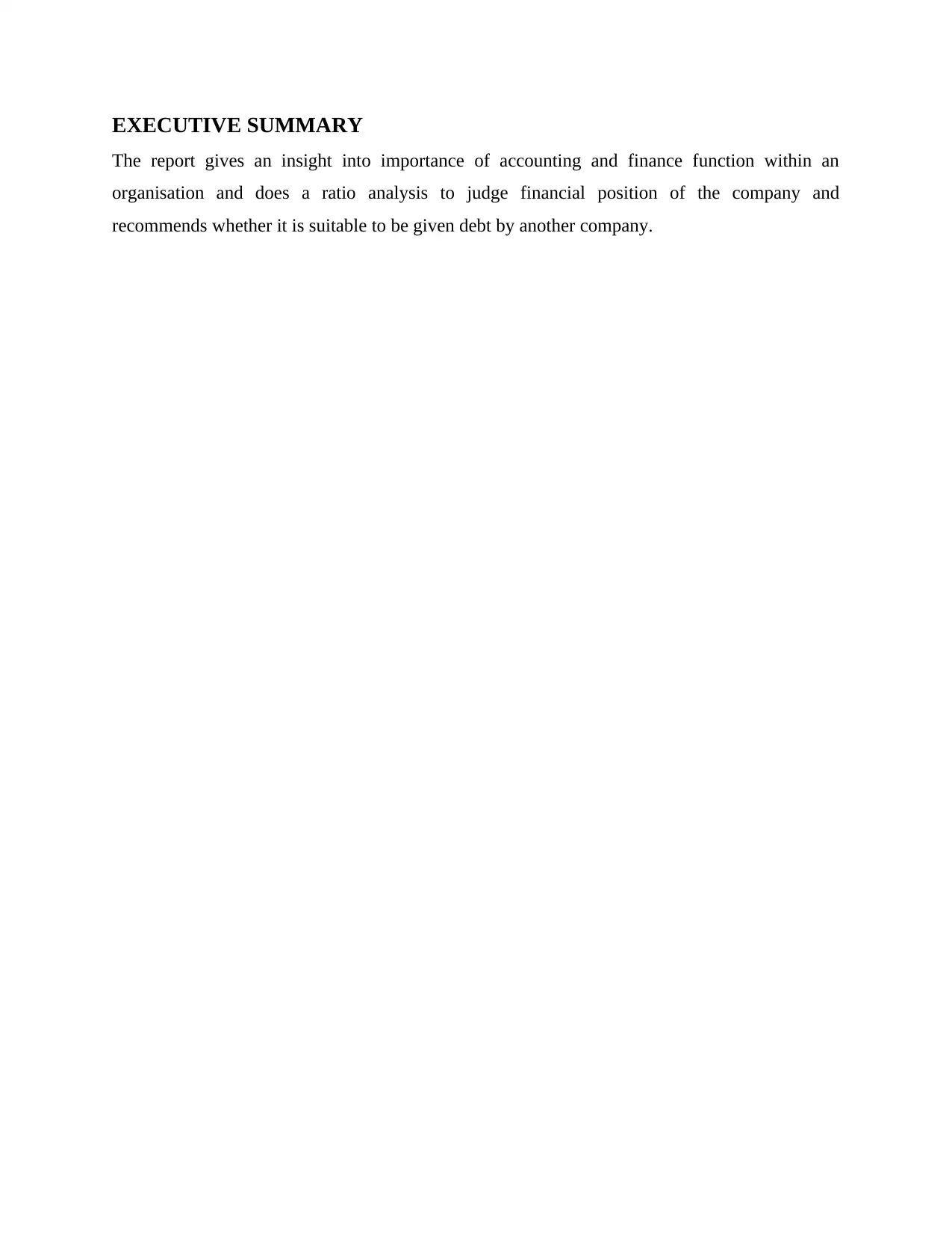
EXECUTIVE SUMMARY
The report gives an insight into importance of accounting and finance function within an
organisation and does a ratio analysis to judge financial position of the company and
recommends whether it is suitable to be given debt by another company.
The report gives an insight into importance of accounting and finance function within an
organisation and does a ratio analysis to judge financial position of the company and
recommends whether it is suitable to be given debt by another company.
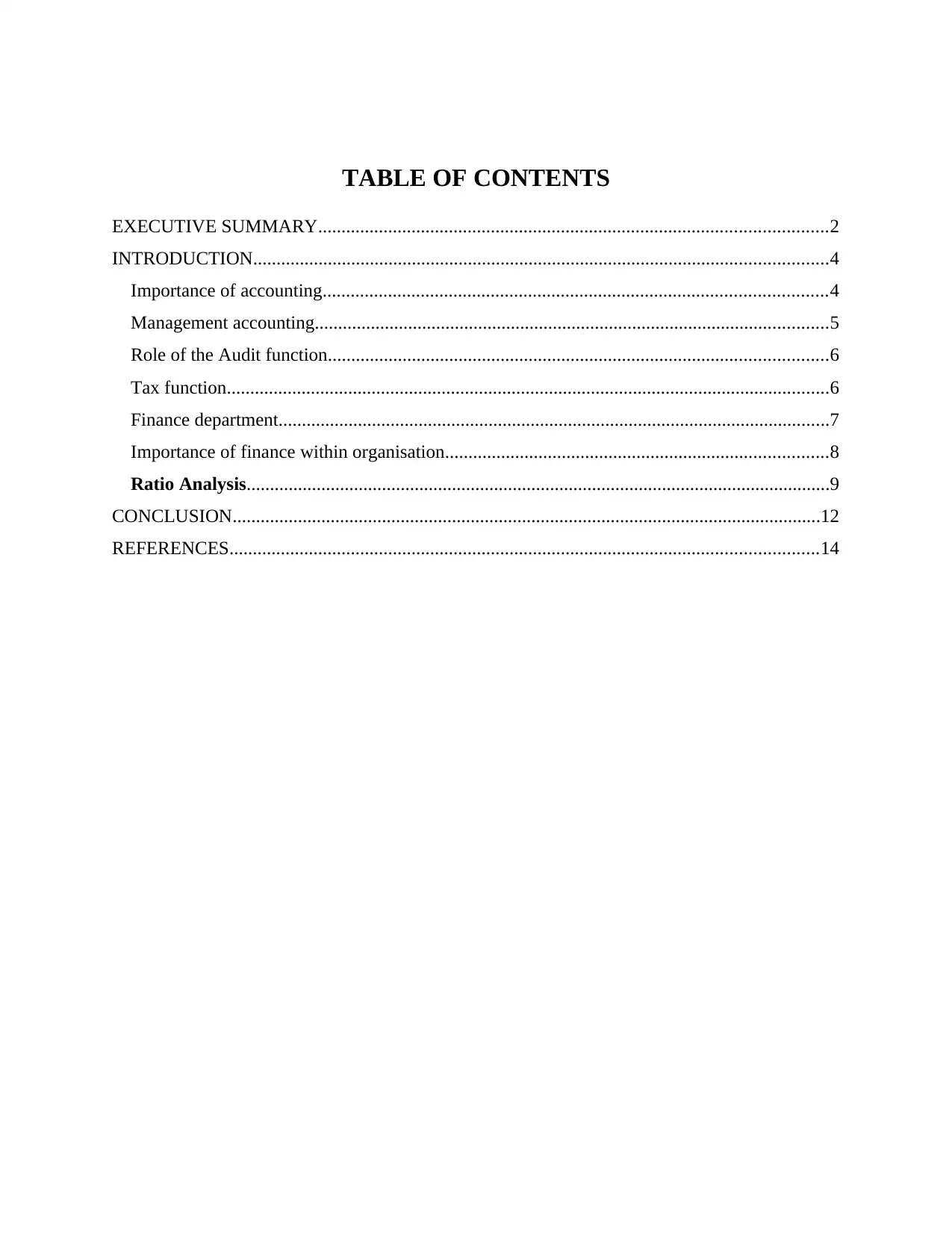
TABLE OF CONTENTS
EXECUTIVE SUMMARY.............................................................................................................2
INTRODUCTION...........................................................................................................................4
Importance of accounting............................................................................................................4
Management accounting..............................................................................................................5
Role of the Audit function...........................................................................................................6
Tax function.................................................................................................................................6
Finance department......................................................................................................................7
Importance of finance within organisation..................................................................................8
Ratio Analysis.............................................................................................................................9
CONCLUSION..............................................................................................................................12
REFERENCES..............................................................................................................................14
EXECUTIVE SUMMARY.............................................................................................................2
INTRODUCTION...........................................................................................................................4
Importance of accounting............................................................................................................4
Management accounting..............................................................................................................5
Role of the Audit function...........................................................................................................6
Tax function.................................................................................................................................6
Finance department......................................................................................................................7
Importance of finance within organisation..................................................................................8
Ratio Analysis.............................................................................................................................9
CONCLUSION..............................................................................................................................12
REFERENCES..............................................................................................................................14
⊘ This is a preview!⊘
Do you want full access?
Subscribe today to unlock all pages.

Trusted by 1+ million students worldwide
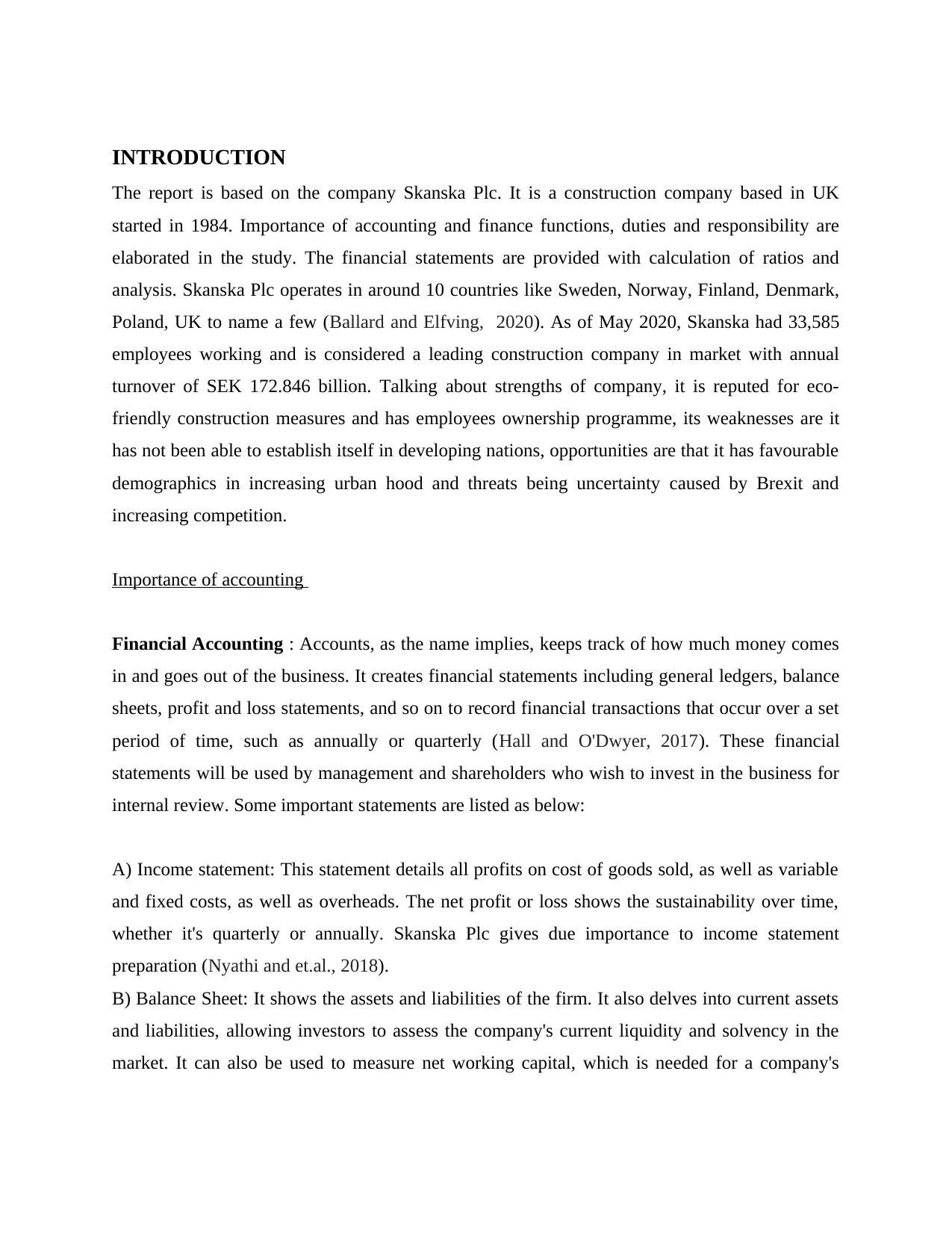
INTRODUCTION
The report is based on the company Skanska Plc. It is a construction company based in UK
started in 1984. Importance of accounting and finance functions, duties and responsibility are
elaborated in the study. The financial statements are provided with calculation of ratios and
analysis. Skanska Plc operates in around 10 countries like Sweden, Norway, Finland, Denmark,
Poland, UK to name a few (Ballard and Elfving, 2020). As of May 2020, Skanska had 33,585
employees working and is considered a leading construction company in market with annual
turnover of SEK 172.846 billion. Talking about strengths of company, it is reputed for eco-
friendly construction measures and has employees ownership programme, its weaknesses are it
has not been able to establish itself in developing nations, opportunities are that it has favourable
demographics in increasing urban hood and threats being uncertainty caused by Brexit and
increasing competition.
Importance of accounting
Financial Accounting : Accounts, as the name implies, keeps track of how much money comes
in and goes out of the business. It creates financial statements including general ledgers, balance
sheets, profit and loss statements, and so on to record financial transactions that occur over a set
period of time, such as annually or quarterly (Hall and O'Dwyer, 2017). These financial
statements will be used by management and shareholders who wish to invest in the business for
internal review. Some important statements are listed as below:
A) Income statement: This statement details all profits on cost of goods sold, as well as variable
and fixed costs, as well as overheads. The net profit or loss shows the sustainability over time,
whether it's quarterly or annually. Skanska Plc gives due importance to income statement
preparation (Nyathi and et.al., 2018).
B) Balance Sheet: It shows the assets and liabilities of the firm. It also delves into current assets
and liabilities, allowing investors to assess the company's current liquidity and solvency in the
market. It can also be used to measure net working capital, which is needed for a company's
The report is based on the company Skanska Plc. It is a construction company based in UK
started in 1984. Importance of accounting and finance functions, duties and responsibility are
elaborated in the study. The financial statements are provided with calculation of ratios and
analysis. Skanska Plc operates in around 10 countries like Sweden, Norway, Finland, Denmark,
Poland, UK to name a few (Ballard and Elfving, 2020). As of May 2020, Skanska had 33,585
employees working and is considered a leading construction company in market with annual
turnover of SEK 172.846 billion. Talking about strengths of company, it is reputed for eco-
friendly construction measures and has employees ownership programme, its weaknesses are it
has not been able to establish itself in developing nations, opportunities are that it has favourable
demographics in increasing urban hood and threats being uncertainty caused by Brexit and
increasing competition.
Importance of accounting
Financial Accounting : Accounts, as the name implies, keeps track of how much money comes
in and goes out of the business. It creates financial statements including general ledgers, balance
sheets, profit and loss statements, and so on to record financial transactions that occur over a set
period of time, such as annually or quarterly (Hall and O'Dwyer, 2017). These financial
statements will be used by management and shareholders who wish to invest in the business for
internal review. Some important statements are listed as below:
A) Income statement: This statement details all profits on cost of goods sold, as well as variable
and fixed costs, as well as overheads. The net profit or loss shows the sustainability over time,
whether it's quarterly or annually. Skanska Plc gives due importance to income statement
preparation (Nyathi and et.al., 2018).
B) Balance Sheet: It shows the assets and liabilities of the firm. It also delves into current assets
and liabilities, allowing investors to assess the company's current liquidity and solvency in the
market. It can also be used to measure net working capital, which is needed for a company's
Paraphrase This Document
Need a fresh take? Get an instant paraphrase of this document with our AI Paraphraser
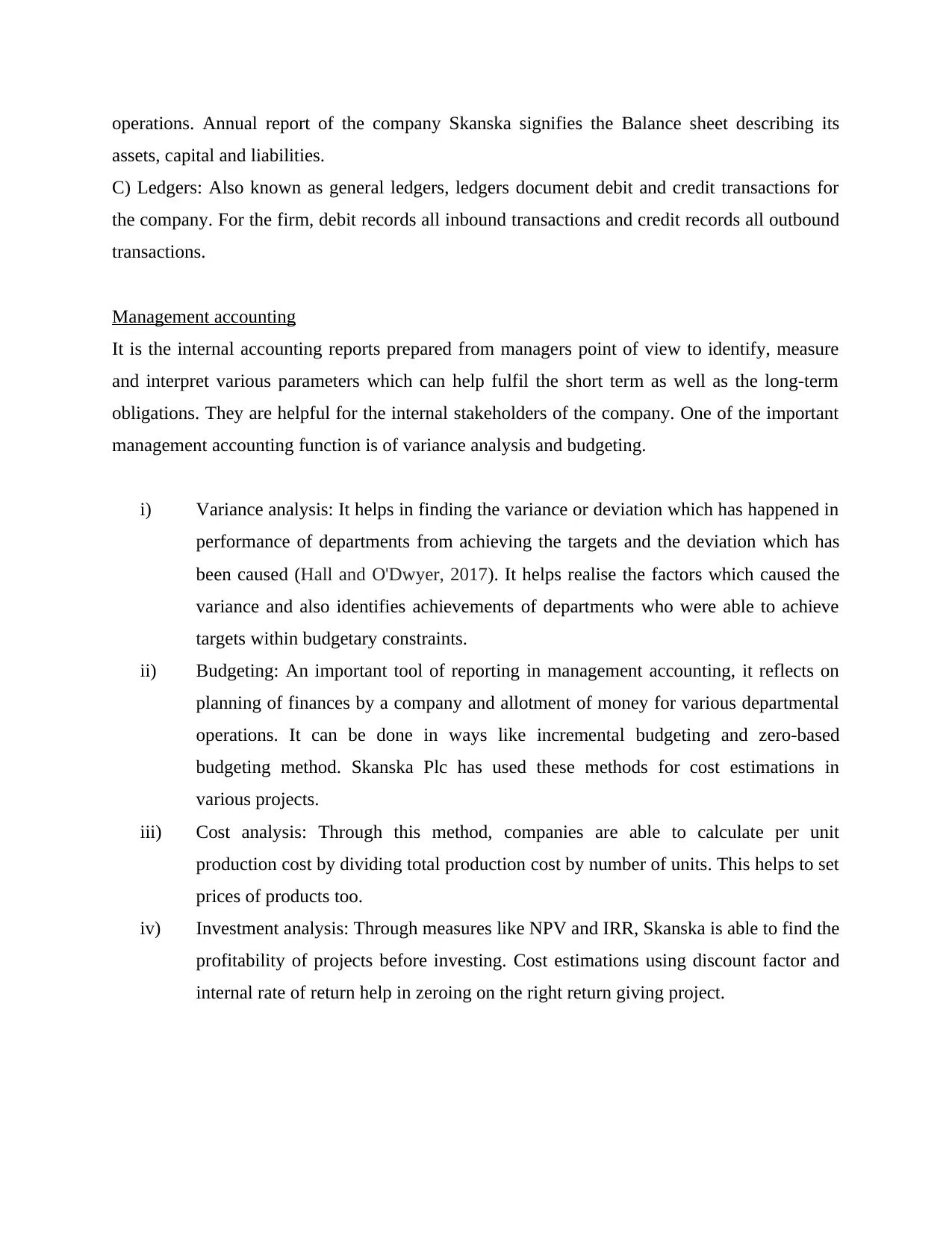
operations. Annual report of the company Skanska signifies the Balance sheet describing its
assets, capital and liabilities.
C) Ledgers: Also known as general ledgers, ledgers document debit and credit transactions for
the company. For the firm, debit records all inbound transactions and credit records all outbound
transactions.
Management accounting
It is the internal accounting reports prepared from managers point of view to identify, measure
and interpret various parameters which can help fulfil the short term as well as the long-term
obligations. They are helpful for the internal stakeholders of the company. One of the important
management accounting function is of variance analysis and budgeting.
i) Variance analysis: It helps in finding the variance or deviation which has happened in
performance of departments from achieving the targets and the deviation which has
been caused (Hall and O'Dwyer, 2017). It helps realise the factors which caused the
variance and also identifies achievements of departments who were able to achieve
targets within budgetary constraints.
ii) Budgeting: An important tool of reporting in management accounting, it reflects on
planning of finances by a company and allotment of money for various departmental
operations. It can be done in ways like incremental budgeting and zero-based
budgeting method. Skanska Plc has used these methods for cost estimations in
various projects.
iii) Cost analysis: Through this method, companies are able to calculate per unit
production cost by dividing total production cost by number of units. This helps to set
prices of products too.
iv) Investment analysis: Through measures like NPV and IRR, Skanska is able to find the
profitability of projects before investing. Cost estimations using discount factor and
internal rate of return help in zeroing on the right return giving project.
assets, capital and liabilities.
C) Ledgers: Also known as general ledgers, ledgers document debit and credit transactions for
the company. For the firm, debit records all inbound transactions and credit records all outbound
transactions.
Management accounting
It is the internal accounting reports prepared from managers point of view to identify, measure
and interpret various parameters which can help fulfil the short term as well as the long-term
obligations. They are helpful for the internal stakeholders of the company. One of the important
management accounting function is of variance analysis and budgeting.
i) Variance analysis: It helps in finding the variance or deviation which has happened in
performance of departments from achieving the targets and the deviation which has
been caused (Hall and O'Dwyer, 2017). It helps realise the factors which caused the
variance and also identifies achievements of departments who were able to achieve
targets within budgetary constraints.
ii) Budgeting: An important tool of reporting in management accounting, it reflects on
planning of finances by a company and allotment of money for various departmental
operations. It can be done in ways like incremental budgeting and zero-based
budgeting method. Skanska Plc has used these methods for cost estimations in
various projects.
iii) Cost analysis: Through this method, companies are able to calculate per unit
production cost by dividing total production cost by number of units. This helps to set
prices of products too.
iv) Investment analysis: Through measures like NPV and IRR, Skanska is able to find the
profitability of projects before investing. Cost estimations using discount factor and
internal rate of return help in zeroing on the right return giving project.
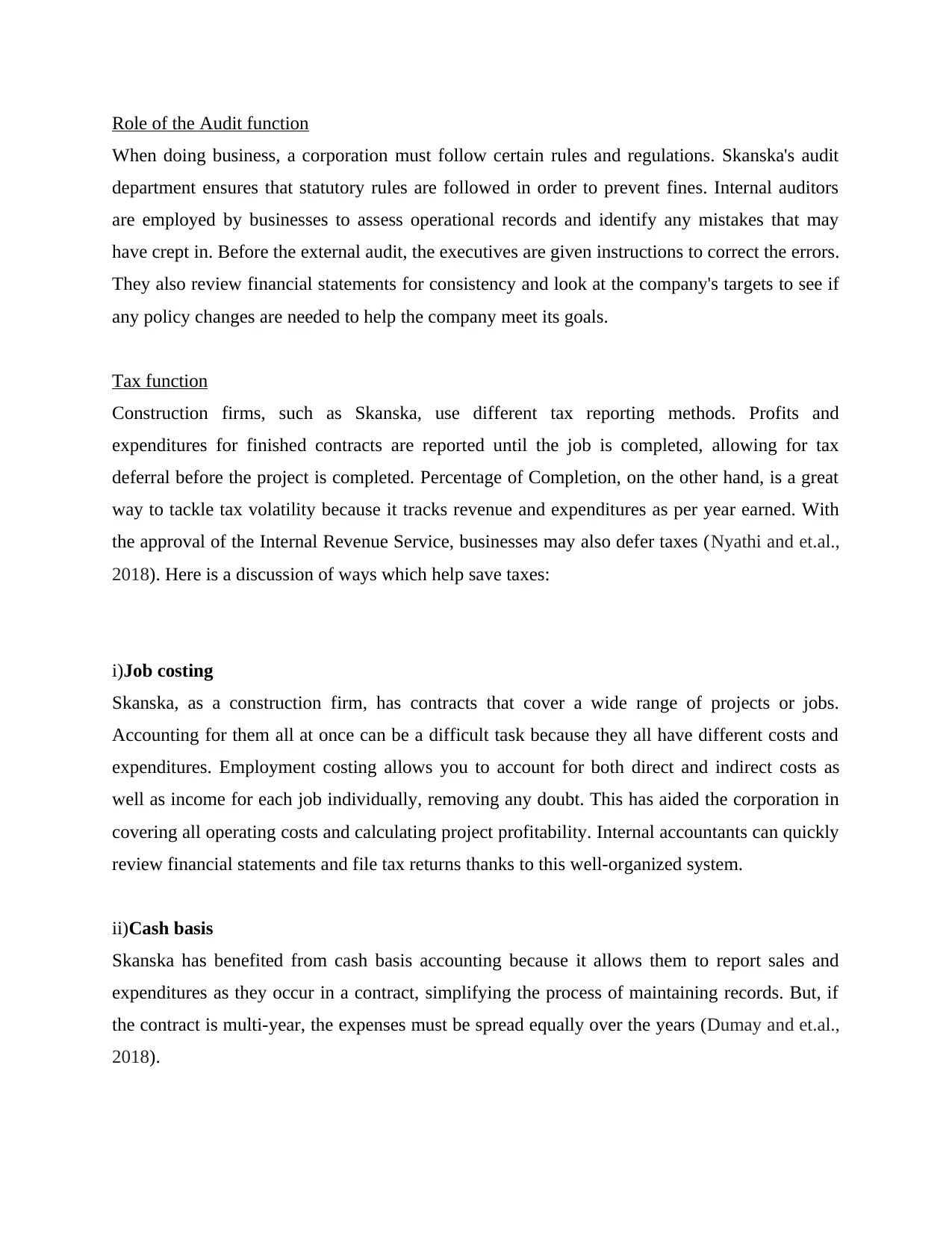
Role of the Audit function
When doing business, a corporation must follow certain rules and regulations. Skanska's audit
department ensures that statutory rules are followed in order to prevent fines. Internal auditors
are employed by businesses to assess operational records and identify any mistakes that may
have crept in. Before the external audit, the executives are given instructions to correct the errors.
They also review financial statements for consistency and look at the company's targets to see if
any policy changes are needed to help the company meet its goals.
Tax function
Construction firms, such as Skanska, use different tax reporting methods. Profits and
expenditures for finished contracts are reported until the job is completed, allowing for tax
deferral before the project is completed. Percentage of Completion, on the other hand, is a great
way to tackle tax volatility because it tracks revenue and expenditures as per year earned. With
the approval of the Internal Revenue Service, businesses may also defer taxes (Nyathi and et.al.,
2018). Here is a discussion of ways which help save taxes:
i)Job costing
Skanska, as a construction firm, has contracts that cover a wide range of projects or jobs.
Accounting for them all at once can be a difficult task because they all have different costs and
expenditures. Employment costing allows you to account for both direct and indirect costs as
well as income for each job individually, removing any doubt. This has aided the corporation in
covering all operating costs and calculating project profitability. Internal accountants can quickly
review financial statements and file tax returns thanks to this well-organized system.
ii)Cash basis
Skanska has benefited from cash basis accounting because it allows them to report sales and
expenditures as they occur in a contract, simplifying the process of maintaining records. But, if
the contract is multi-year, the expenses must be spread equally over the years (Dumay and et.al.,
2018).
When doing business, a corporation must follow certain rules and regulations. Skanska's audit
department ensures that statutory rules are followed in order to prevent fines. Internal auditors
are employed by businesses to assess operational records and identify any mistakes that may
have crept in. Before the external audit, the executives are given instructions to correct the errors.
They also review financial statements for consistency and look at the company's targets to see if
any policy changes are needed to help the company meet its goals.
Tax function
Construction firms, such as Skanska, use different tax reporting methods. Profits and
expenditures for finished contracts are reported until the job is completed, allowing for tax
deferral before the project is completed. Percentage of Completion, on the other hand, is a great
way to tackle tax volatility because it tracks revenue and expenditures as per year earned. With
the approval of the Internal Revenue Service, businesses may also defer taxes (Nyathi and et.al.,
2018). Here is a discussion of ways which help save taxes:
i)Job costing
Skanska, as a construction firm, has contracts that cover a wide range of projects or jobs.
Accounting for them all at once can be a difficult task because they all have different costs and
expenditures. Employment costing allows you to account for both direct and indirect costs as
well as income for each job individually, removing any doubt. This has aided the corporation in
covering all operating costs and calculating project profitability. Internal accountants can quickly
review financial statements and file tax returns thanks to this well-organized system.
ii)Cash basis
Skanska has benefited from cash basis accounting because it allows them to report sales and
expenditures as they occur in a contract, simplifying the process of maintaining records. But, if
the contract is multi-year, the expenses must be spread equally over the years (Dumay and et.al.,
2018).
⊘ This is a preview!⊘
Do you want full access?
Subscribe today to unlock all pages.

Trusted by 1+ million students worldwide
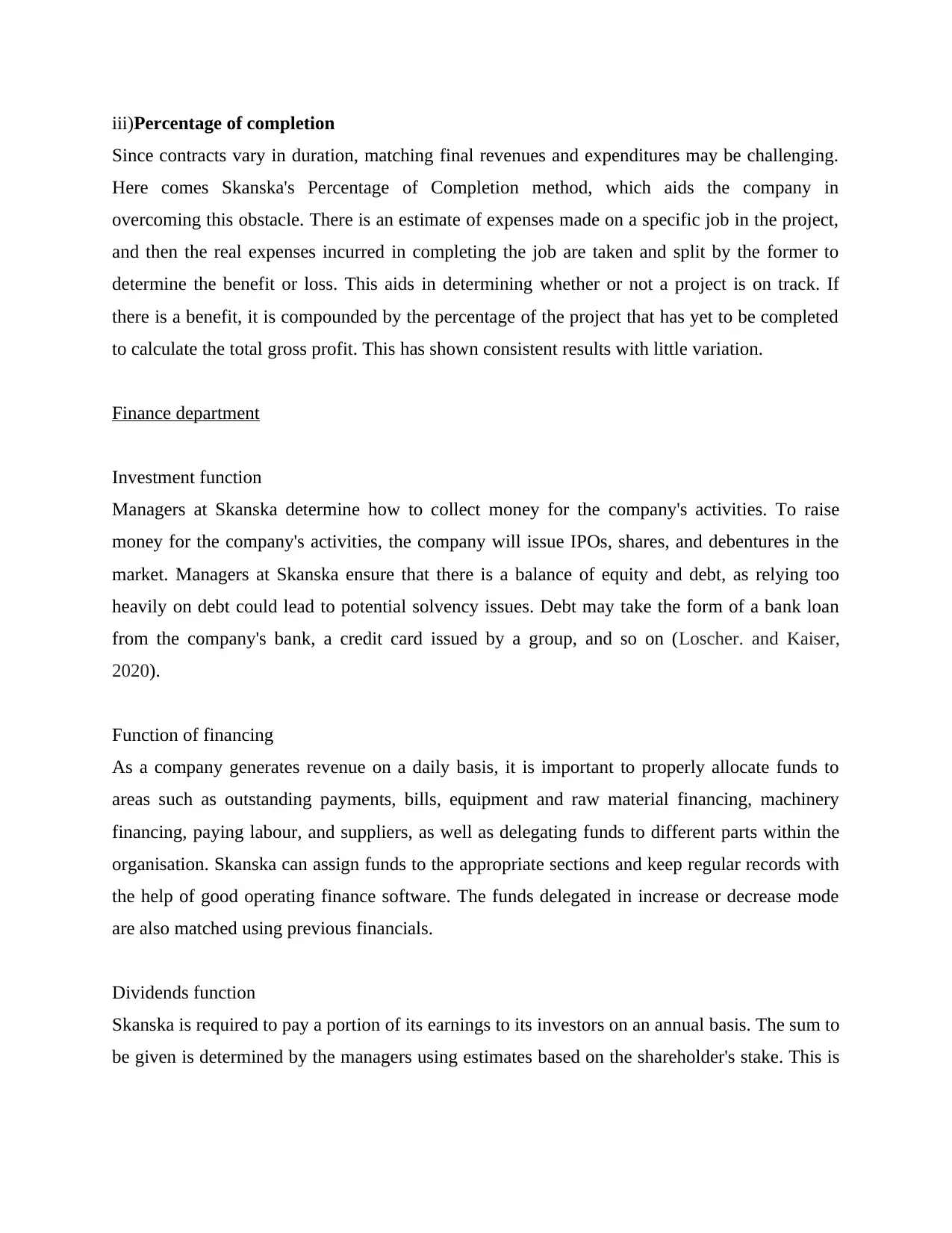
iii)Percentage of completion
Since contracts vary in duration, matching final revenues and expenditures may be challenging.
Here comes Skanska's Percentage of Completion method, which aids the company in
overcoming this obstacle. There is an estimate of expenses made on a specific job in the project,
and then the real expenses incurred in completing the job are taken and split by the former to
determine the benefit or loss. This aids in determining whether or not a project is on track. If
there is a benefit, it is compounded by the percentage of the project that has yet to be completed
to calculate the total gross profit. This has shown consistent results with little variation.
Finance department
Investment function
Managers at Skanska determine how to collect money for the company's activities. To raise
money for the company's activities, the company will issue IPOs, shares, and debentures in the
market. Managers at Skanska ensure that there is a balance of equity and debt, as relying too
heavily on debt could lead to potential solvency issues. Debt may take the form of a bank loan
from the company's bank, a credit card issued by a group, and so on (Loscher. and Kaiser,
2020).
Function of financing
As a company generates revenue on a daily basis, it is important to properly allocate funds to
areas such as outstanding payments, bills, equipment and raw material financing, machinery
financing, paying labour, and suppliers, as well as delegating funds to different parts within the
organisation. Skanska can assign funds to the appropriate sections and keep regular records with
the help of good operating finance software. The funds delegated in increase or decrease mode
are also matched using previous financials.
Dividends function
Skanska is required to pay a portion of its earnings to its investors on an annual basis. The sum to
be given is determined by the managers using estimates based on the shareholder's stake. This is
Since contracts vary in duration, matching final revenues and expenditures may be challenging.
Here comes Skanska's Percentage of Completion method, which aids the company in
overcoming this obstacle. There is an estimate of expenses made on a specific job in the project,
and then the real expenses incurred in completing the job are taken and split by the former to
determine the benefit or loss. This aids in determining whether or not a project is on track. If
there is a benefit, it is compounded by the percentage of the project that has yet to be completed
to calculate the total gross profit. This has shown consistent results with little variation.
Finance department
Investment function
Managers at Skanska determine how to collect money for the company's activities. To raise
money for the company's activities, the company will issue IPOs, shares, and debentures in the
market. Managers at Skanska ensure that there is a balance of equity and debt, as relying too
heavily on debt could lead to potential solvency issues. Debt may take the form of a bank loan
from the company's bank, a credit card issued by a group, and so on (Loscher. and Kaiser,
2020).
Function of financing
As a company generates revenue on a daily basis, it is important to properly allocate funds to
areas such as outstanding payments, bills, equipment and raw material financing, machinery
financing, paying labour, and suppliers, as well as delegating funds to different parts within the
organisation. Skanska can assign funds to the appropriate sections and keep regular records with
the help of good operating finance software. The funds delegated in increase or decrease mode
are also matched using previous financials.
Dividends function
Skanska is required to pay a portion of its earnings to its investors on an annual basis. The sum to
be given is determined by the managers using estimates based on the shareholder's stake. This is
Paraphrase This Document
Need a fresh take? Get an instant paraphrase of this document with our AI Paraphraser
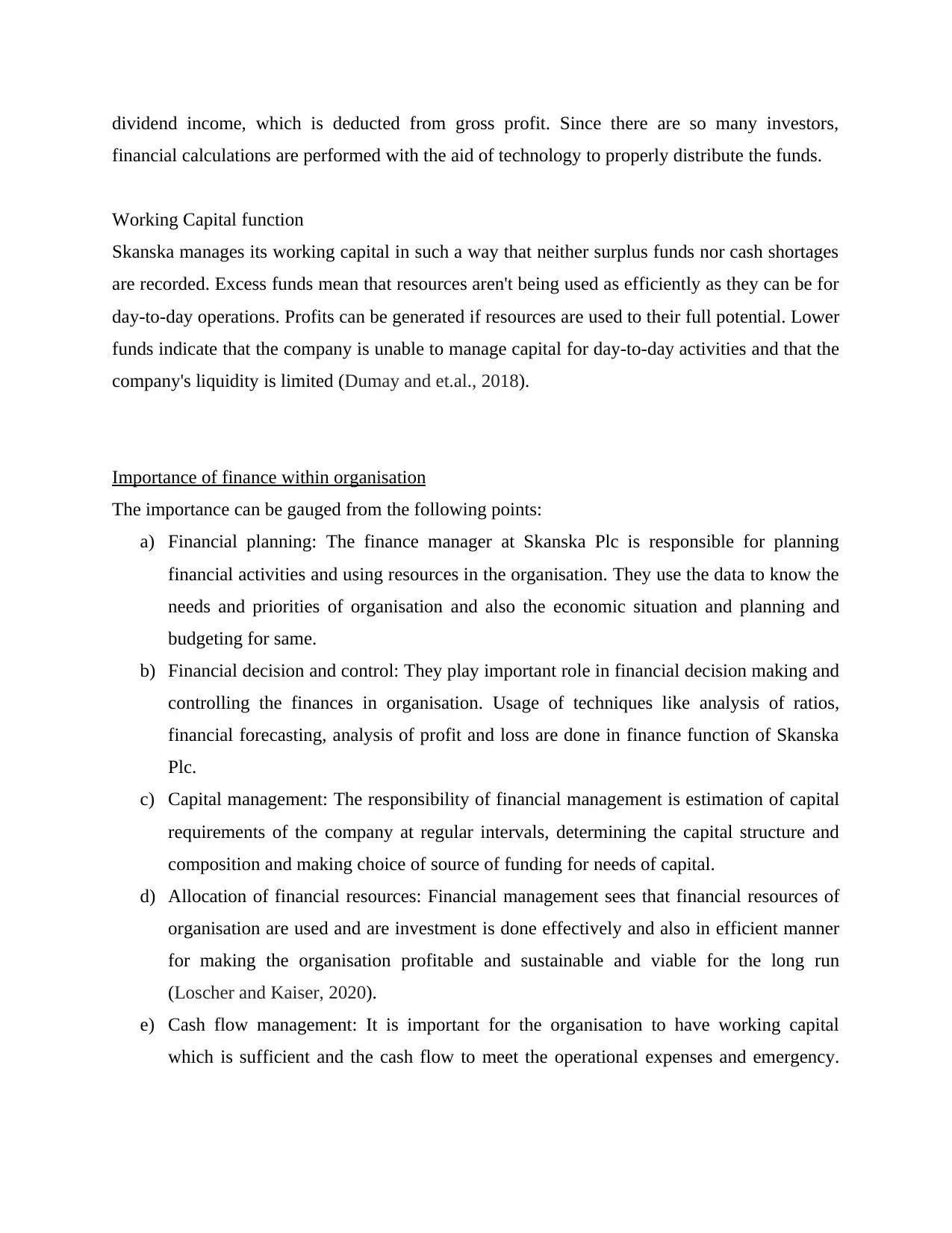
dividend income, which is deducted from gross profit. Since there are so many investors,
financial calculations are performed with the aid of technology to properly distribute the funds.
Working Capital function
Skanska manages its working capital in such a way that neither surplus funds nor cash shortages
are recorded. Excess funds mean that resources aren't being used as efficiently as they can be for
day-to-day operations. Profits can be generated if resources are used to their full potential. Lower
funds indicate that the company is unable to manage capital for day-to-day activities and that the
company's liquidity is limited (Dumay and et.al., 2018).
Importance of finance within organisation
The importance can be gauged from the following points:
a) Financial planning: The finance manager at Skanska Plc is responsible for planning
financial activities and using resources in the organisation. They use the data to know the
needs and priorities of organisation and also the economic situation and planning and
budgeting for same.
b) Financial decision and control: They play important role in financial decision making and
controlling the finances in organisation. Usage of techniques like analysis of ratios,
financial forecasting, analysis of profit and loss are done in finance function of Skanska
Plc.
c) Capital management: The responsibility of financial management is estimation of capital
requirements of the company at regular intervals, determining the capital structure and
composition and making choice of source of funding for needs of capital.
d) Allocation of financial resources: Financial management sees that financial resources of
organisation are used and are investment is done effectively and also in efficient manner
for making the organisation profitable and sustainable and viable for the long run
(Loscher and Kaiser, 2020).
e) Cash flow management: It is important for the organisation to have working capital
which is sufficient and the cash flow to meet the operational expenses and emergency.
financial calculations are performed with the aid of technology to properly distribute the funds.
Working Capital function
Skanska manages its working capital in such a way that neither surplus funds nor cash shortages
are recorded. Excess funds mean that resources aren't being used as efficiently as they can be for
day-to-day operations. Profits can be generated if resources are used to their full potential. Lower
funds indicate that the company is unable to manage capital for day-to-day activities and that the
company's liquidity is limited (Dumay and et.al., 2018).
Importance of finance within organisation
The importance can be gauged from the following points:
a) Financial planning: The finance manager at Skanska Plc is responsible for planning
financial activities and using resources in the organisation. They use the data to know the
needs and priorities of organisation and also the economic situation and planning and
budgeting for same.
b) Financial decision and control: They play important role in financial decision making and
controlling the finances in organisation. Usage of techniques like analysis of ratios,
financial forecasting, analysis of profit and loss are done in finance function of Skanska
Plc.
c) Capital management: The responsibility of financial management is estimation of capital
requirements of the company at regular intervals, determining the capital structure and
composition and making choice of source of funding for needs of capital.
d) Allocation of financial resources: Financial management sees that financial resources of
organisation are used and are investment is done effectively and also in efficient manner
for making the organisation profitable and sustainable and viable for the long run
(Loscher and Kaiser, 2020).
e) Cash flow management: It is important for the organisation to have working capital
which is sufficient and the cash flow to meet the operational expenses and emergency.
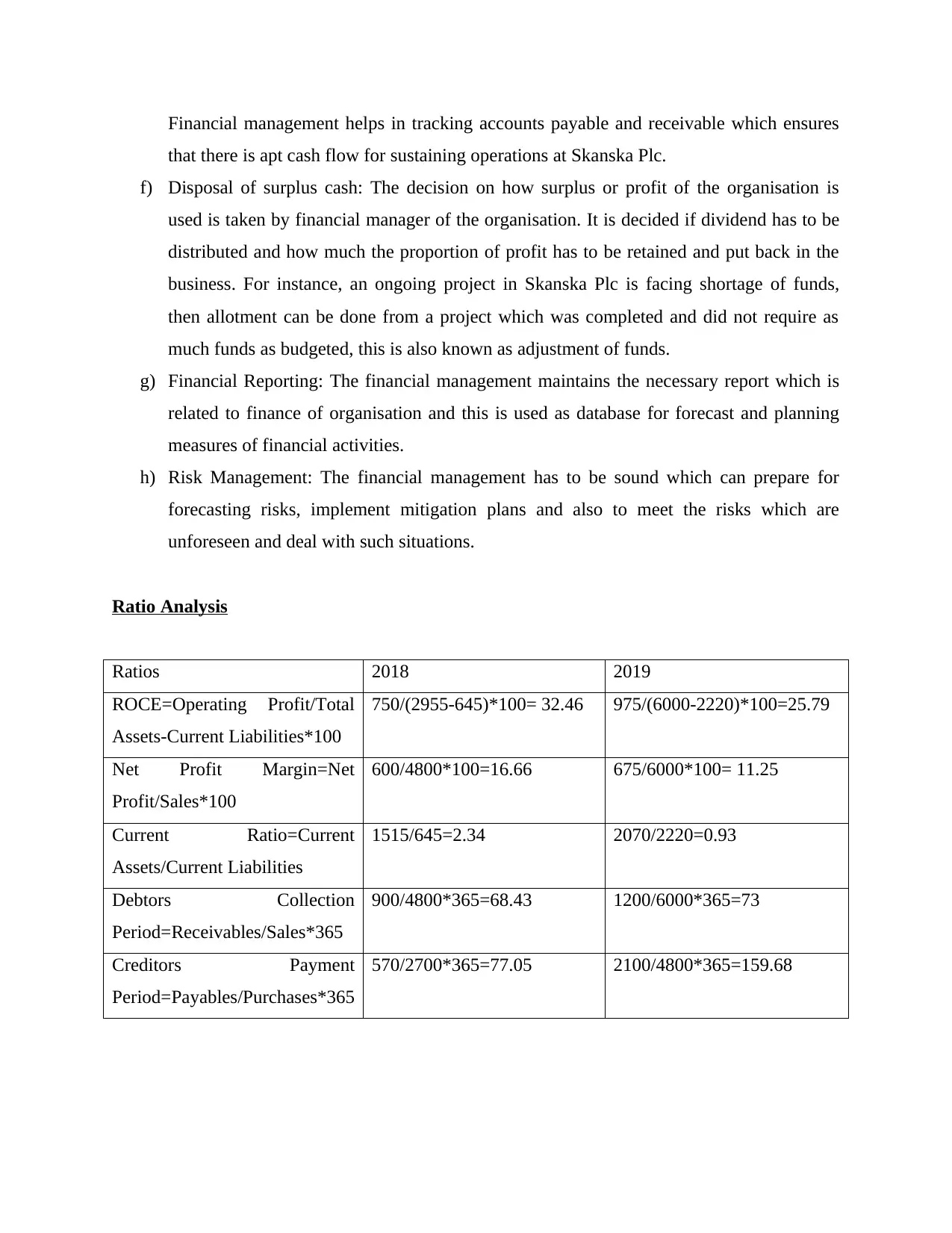
Financial management helps in tracking accounts payable and receivable which ensures
that there is apt cash flow for sustaining operations at Skanska Plc.
f) Disposal of surplus cash: The decision on how surplus or profit of the organisation is
used is taken by financial manager of the organisation. It is decided if dividend has to be
distributed and how much the proportion of profit has to be retained and put back in the
business. For instance, an ongoing project in Skanska Plc is facing shortage of funds,
then allotment can be done from a project which was completed and did not require as
much funds as budgeted, this is also known as adjustment of funds.
g) Financial Reporting: The financial management maintains the necessary report which is
related to finance of organisation and this is used as database for forecast and planning
measures of financial activities.
h) Risk Management: The financial management has to be sound which can prepare for
forecasting risks, implement mitigation plans and also to meet the risks which are
unforeseen and deal with such situations.
Ratio Analysis
Ratios 2018 2019
ROCE=Operating Profit/Total
Assets-Current Liabilities*100
750/(2955-645)*100= 32.46 975/(6000-2220)*100=25.79
Net Profit Margin=Net
Profit/Sales*100
600/4800*100=16.66 675/6000*100= 11.25
Current Ratio=Current
Assets/Current Liabilities
1515/645=2.34 2070/2220=0.93
Debtors Collection
Period=Receivables/Sales*365
900/4800*365=68.43 1200/6000*365=73
Creditors Payment
Period=Payables/Purchases*365
570/2700*365=77.05 2100/4800*365=159.68
that there is apt cash flow for sustaining operations at Skanska Plc.
f) Disposal of surplus cash: The decision on how surplus or profit of the organisation is
used is taken by financial manager of the organisation. It is decided if dividend has to be
distributed and how much the proportion of profit has to be retained and put back in the
business. For instance, an ongoing project in Skanska Plc is facing shortage of funds,
then allotment can be done from a project which was completed and did not require as
much funds as budgeted, this is also known as adjustment of funds.
g) Financial Reporting: The financial management maintains the necessary report which is
related to finance of organisation and this is used as database for forecast and planning
measures of financial activities.
h) Risk Management: The financial management has to be sound which can prepare for
forecasting risks, implement mitigation plans and also to meet the risks which are
unforeseen and deal with such situations.
Ratio Analysis
Ratios 2018 2019
ROCE=Operating Profit/Total
Assets-Current Liabilities*100
750/(2955-645)*100= 32.46 975/(6000-2220)*100=25.79
Net Profit Margin=Net
Profit/Sales*100
600/4800*100=16.66 675/6000*100= 11.25
Current Ratio=Current
Assets/Current Liabilities
1515/645=2.34 2070/2220=0.93
Debtors Collection
Period=Receivables/Sales*365
900/4800*365=68.43 1200/6000*365=73
Creditors Payment
Period=Payables/Purchases*365
570/2700*365=77.05 2100/4800*365=159.68
⊘ This is a preview!⊘
Do you want full access?
Subscribe today to unlock all pages.

Trusted by 1+ million students worldwide
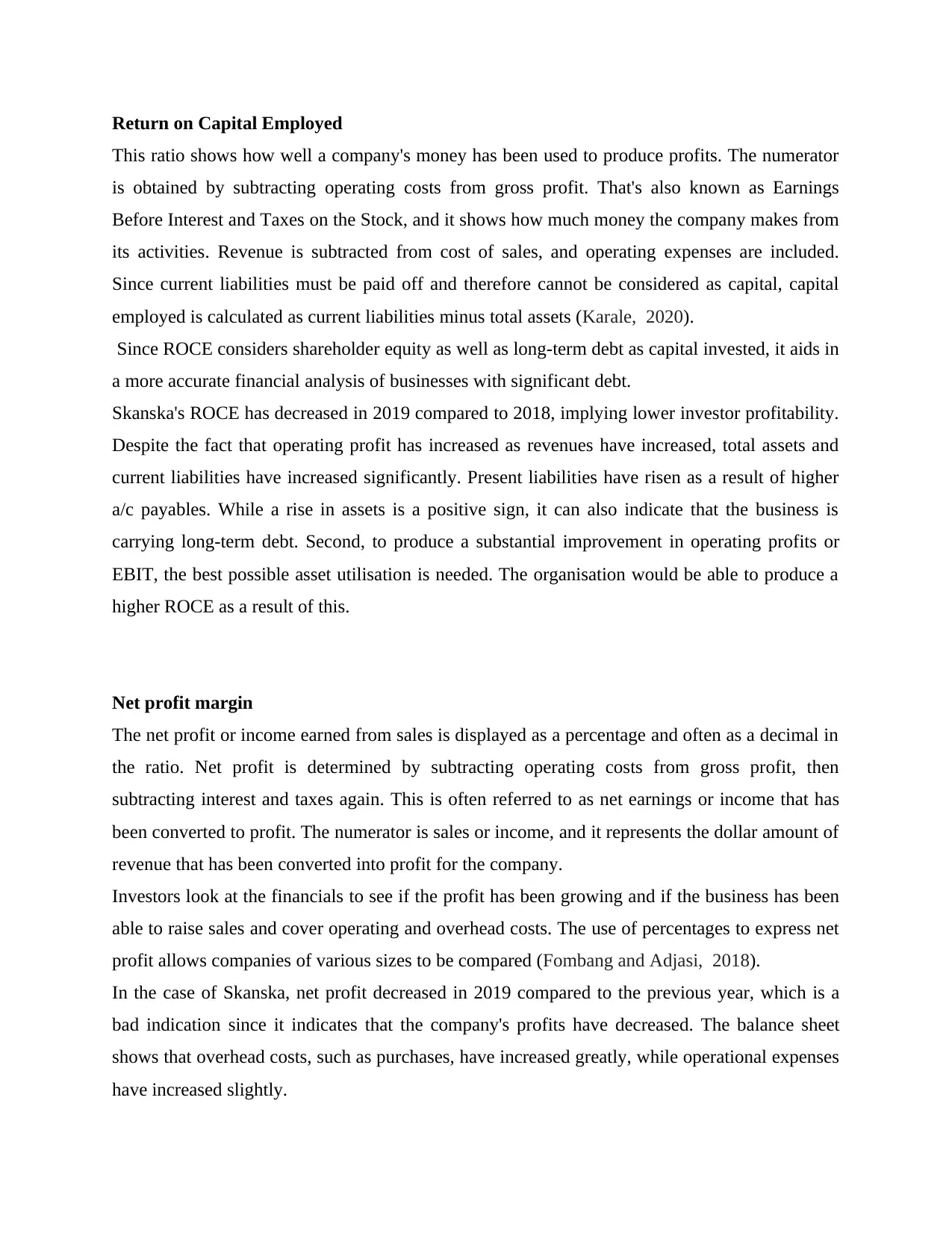
Return on Capital Employed
This ratio shows how well a company's money has been used to produce profits. The numerator
is obtained by subtracting operating costs from gross profit. That's also known as Earnings
Before Interest and Taxes on the Stock, and it shows how much money the company makes from
its activities. Revenue is subtracted from cost of sales, and operating expenses are included.
Since current liabilities must be paid off and therefore cannot be considered as capital, capital
employed is calculated as current liabilities minus total assets (Karale, 2020).
Since ROCE considers shareholder equity as well as long-term debt as capital invested, it aids in
a more accurate financial analysis of businesses with significant debt.
Skanska's ROCE has decreased in 2019 compared to 2018, implying lower investor profitability.
Despite the fact that operating profit has increased as revenues have increased, total assets and
current liabilities have increased significantly. Present liabilities have risen as a result of higher
a/c payables. While a rise in assets is a positive sign, it can also indicate that the business is
carrying long-term debt. Second, to produce a substantial improvement in operating profits or
EBIT, the best possible asset utilisation is needed. The organisation would be able to produce a
higher ROCE as a result of this.
Net profit margin
The net profit or income earned from sales is displayed as a percentage and often as a decimal in
the ratio. Net profit is determined by subtracting operating costs from gross profit, then
subtracting interest and taxes again. This is often referred to as net earnings or income that has
been converted to profit. The numerator is sales or income, and it represents the dollar amount of
revenue that has been converted into profit for the company.
Investors look at the financials to see if the profit has been growing and if the business has been
able to raise sales and cover operating and overhead costs. The use of percentages to express net
profit allows companies of various sizes to be compared (Fombang and Adjasi, 2018).
In the case of Skanska, net profit decreased in 2019 compared to the previous year, which is a
bad indication since it indicates that the company's profits have decreased. The balance sheet
shows that overhead costs, such as purchases, have increased greatly, while operational expenses
have increased slightly.
This ratio shows how well a company's money has been used to produce profits. The numerator
is obtained by subtracting operating costs from gross profit. That's also known as Earnings
Before Interest and Taxes on the Stock, and it shows how much money the company makes from
its activities. Revenue is subtracted from cost of sales, and operating expenses are included.
Since current liabilities must be paid off and therefore cannot be considered as capital, capital
employed is calculated as current liabilities minus total assets (Karale, 2020).
Since ROCE considers shareholder equity as well as long-term debt as capital invested, it aids in
a more accurate financial analysis of businesses with significant debt.
Skanska's ROCE has decreased in 2019 compared to 2018, implying lower investor profitability.
Despite the fact that operating profit has increased as revenues have increased, total assets and
current liabilities have increased significantly. Present liabilities have risen as a result of higher
a/c payables. While a rise in assets is a positive sign, it can also indicate that the business is
carrying long-term debt. Second, to produce a substantial improvement in operating profits or
EBIT, the best possible asset utilisation is needed. The organisation would be able to produce a
higher ROCE as a result of this.
Net profit margin
The net profit or income earned from sales is displayed as a percentage and often as a decimal in
the ratio. Net profit is determined by subtracting operating costs from gross profit, then
subtracting interest and taxes again. This is often referred to as net earnings or income that has
been converted to profit. The numerator is sales or income, and it represents the dollar amount of
revenue that has been converted into profit for the company.
Investors look at the financials to see if the profit has been growing and if the business has been
able to raise sales and cover operating and overhead costs. The use of percentages to express net
profit allows companies of various sizes to be compared (Fombang and Adjasi, 2018).
In the case of Skanska, net profit decreased in 2019 compared to the previous year, which is a
bad indication since it indicates that the company's profits have decreased. The balance sheet
shows that overhead costs, such as purchases, have increased greatly, while operational expenses
have increased slightly.
Paraphrase This Document
Need a fresh take? Get an instant paraphrase of this document with our AI Paraphraser
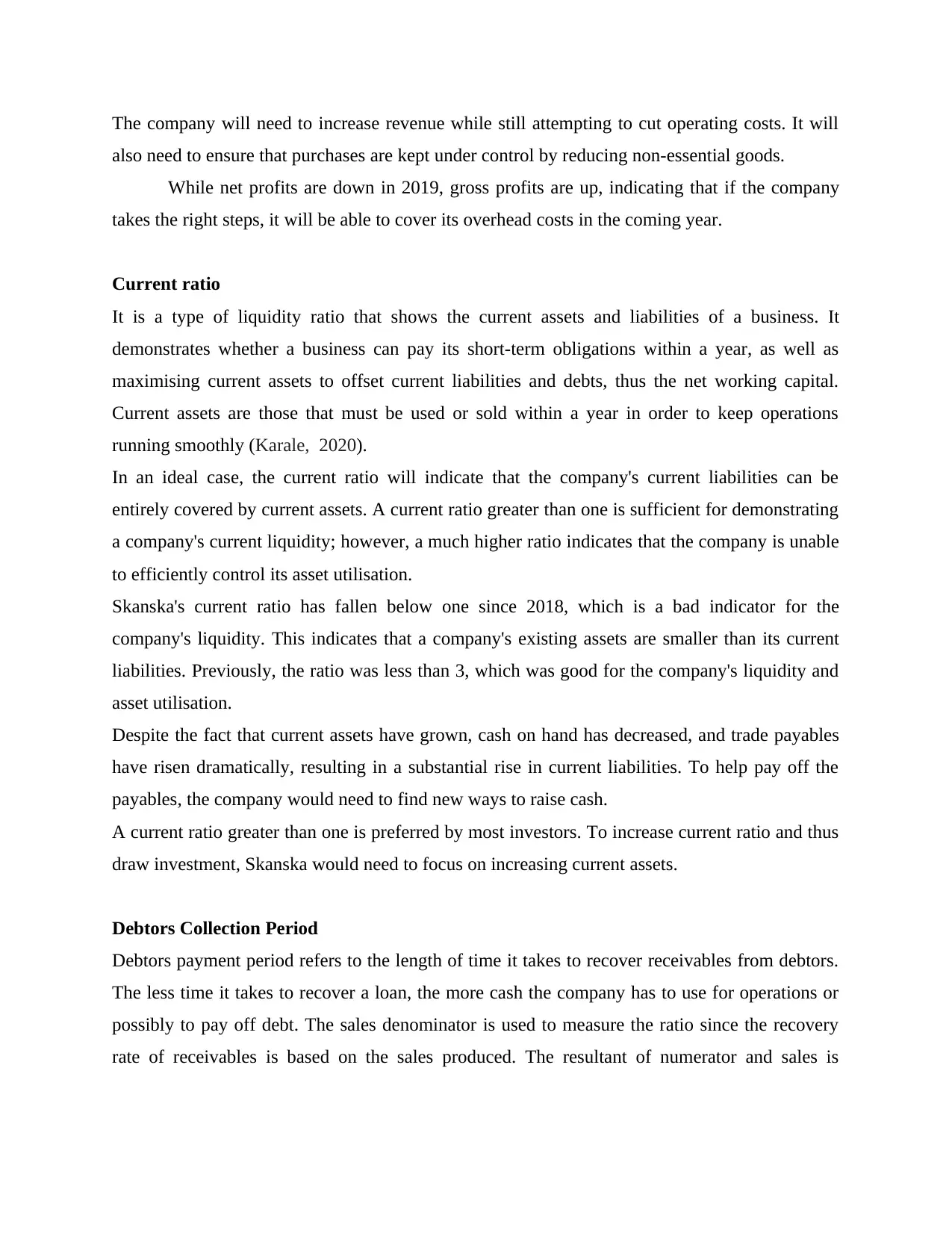
The company will need to increase revenue while still attempting to cut operating costs. It will
also need to ensure that purchases are kept under control by reducing non-essential goods.
While net profits are down in 2019, gross profits are up, indicating that if the company
takes the right steps, it will be able to cover its overhead costs in the coming year.
Current ratio
It is a type of liquidity ratio that shows the current assets and liabilities of a business. It
demonstrates whether a business can pay its short-term obligations within a year, as well as
maximising current assets to offset current liabilities and debts, thus the net working capital.
Current assets are those that must be used or sold within a year in order to keep operations
running smoothly (Karale, 2020).
In an ideal case, the current ratio will indicate that the company's current liabilities can be
entirely covered by current assets. A current ratio greater than one is sufficient for demonstrating
a company's current liquidity; however, a much higher ratio indicates that the company is unable
to efficiently control its asset utilisation.
Skanska's current ratio has fallen below one since 2018, which is a bad indicator for the
company's liquidity. This indicates that a company's existing assets are smaller than its current
liabilities. Previously, the ratio was less than 3, which was good for the company's liquidity and
asset utilisation.
Despite the fact that current assets have grown, cash on hand has decreased, and trade payables
have risen dramatically, resulting in a substantial rise in current liabilities. To help pay off the
payables, the company would need to find new ways to raise cash.
A current ratio greater than one is preferred by most investors. To increase current ratio and thus
draw investment, Skanska would need to focus on increasing current assets.
Debtors Collection Period
Debtors payment period refers to the length of time it takes to recover receivables from debtors.
The less time it takes to recover a loan, the more cash the company has to use for operations or
possibly to pay off debt. The sales denominator is used to measure the ratio since the recovery
rate of receivables is based on the sales produced. The resultant of numerator and sales is
also need to ensure that purchases are kept under control by reducing non-essential goods.
While net profits are down in 2019, gross profits are up, indicating that if the company
takes the right steps, it will be able to cover its overhead costs in the coming year.
Current ratio
It is a type of liquidity ratio that shows the current assets and liabilities of a business. It
demonstrates whether a business can pay its short-term obligations within a year, as well as
maximising current assets to offset current liabilities and debts, thus the net working capital.
Current assets are those that must be used or sold within a year in order to keep operations
running smoothly (Karale, 2020).
In an ideal case, the current ratio will indicate that the company's current liabilities can be
entirely covered by current assets. A current ratio greater than one is sufficient for demonstrating
a company's current liquidity; however, a much higher ratio indicates that the company is unable
to efficiently control its asset utilisation.
Skanska's current ratio has fallen below one since 2018, which is a bad indicator for the
company's liquidity. This indicates that a company's existing assets are smaller than its current
liabilities. Previously, the ratio was less than 3, which was good for the company's liquidity and
asset utilisation.
Despite the fact that current assets have grown, cash on hand has decreased, and trade payables
have risen dramatically, resulting in a substantial rise in current liabilities. To help pay off the
payables, the company would need to find new ways to raise cash.
A current ratio greater than one is preferred by most investors. To increase current ratio and thus
draw investment, Skanska would need to focus on increasing current assets.
Debtors Collection Period
Debtors payment period refers to the length of time it takes to recover receivables from debtors.
The less time it takes to recover a loan, the more cash the company has to use for operations or
possibly to pay off debt. The sales denominator is used to measure the ratio since the recovery
rate of receivables is based on the sales produced. The resultant of numerator and sales is
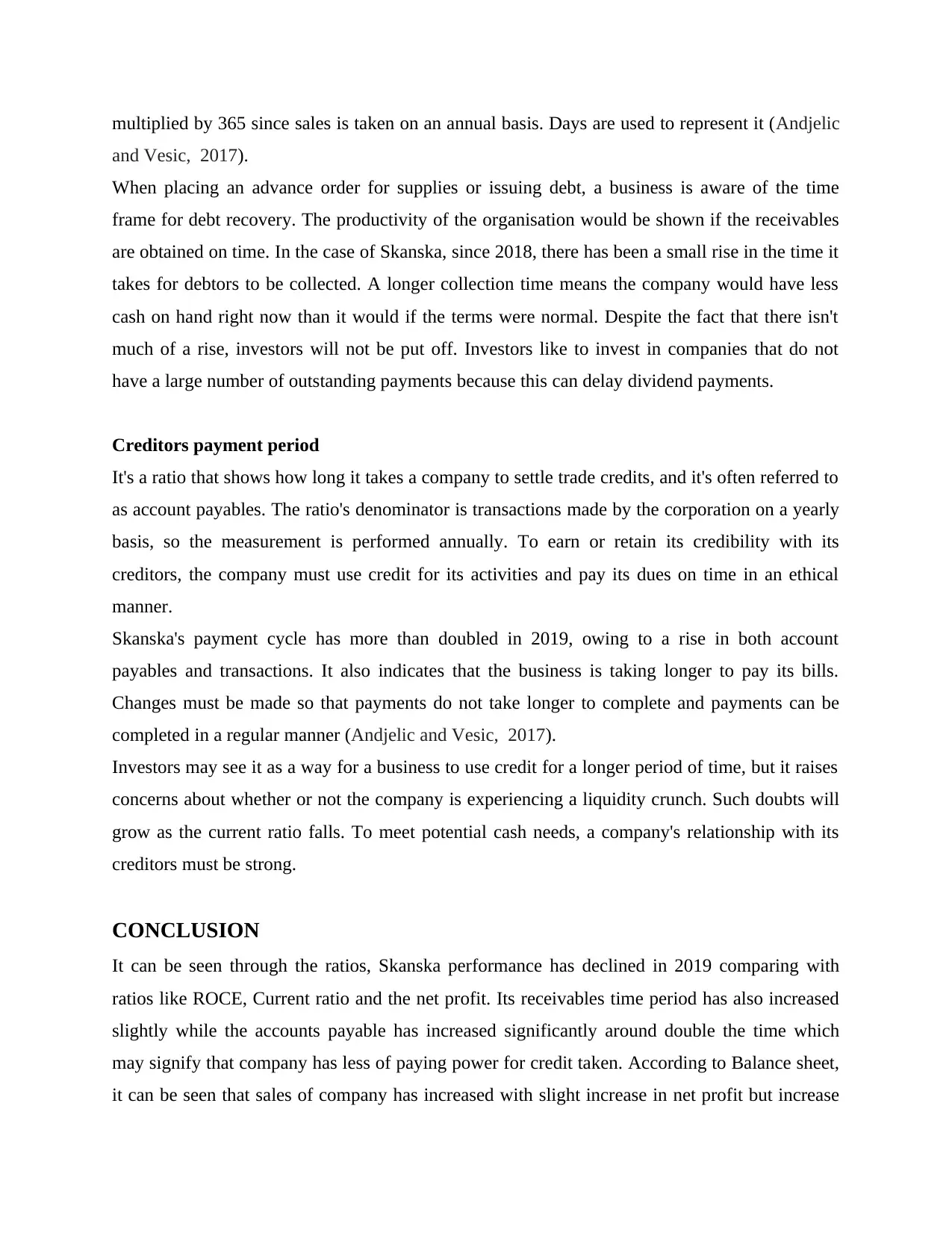
multiplied by 365 since sales is taken on an annual basis. Days are used to represent it (Andjelic
and Vesic, 2017).
When placing an advance order for supplies or issuing debt, a business is aware of the time
frame for debt recovery. The productivity of the organisation would be shown if the receivables
are obtained on time. In the case of Skanska, since 2018, there has been a small rise in the time it
takes for debtors to be collected. A longer collection time means the company would have less
cash on hand right now than it would if the terms were normal. Despite the fact that there isn't
much of a rise, investors will not be put off. Investors like to invest in companies that do not
have a large number of outstanding payments because this can delay dividend payments.
Creditors payment period
It's a ratio that shows how long it takes a company to settle trade credits, and it's often referred to
as account payables. The ratio's denominator is transactions made by the corporation on a yearly
basis, so the measurement is performed annually. To earn or retain its credibility with its
creditors, the company must use credit for its activities and pay its dues on time in an ethical
manner.
Skanska's payment cycle has more than doubled in 2019, owing to a rise in both account
payables and transactions. It also indicates that the business is taking longer to pay its bills.
Changes must be made so that payments do not take longer to complete and payments can be
completed in a regular manner (Andjelic and Vesic, 2017).
Investors may see it as a way for a business to use credit for a longer period of time, but it raises
concerns about whether or not the company is experiencing a liquidity crunch. Such doubts will
grow as the current ratio falls. To meet potential cash needs, a company's relationship with its
creditors must be strong.
CONCLUSION
It can be seen through the ratios, Skanska performance has declined in 2019 comparing with
ratios like ROCE, Current ratio and the net profit. Its receivables time period has also increased
slightly while the accounts payable has increased significantly around double the time which
may signify that company has less of paying power for credit taken. According to Balance sheet,
it can be seen that sales of company has increased with slight increase in net profit but increase
and Vesic, 2017).
When placing an advance order for supplies or issuing debt, a business is aware of the time
frame for debt recovery. The productivity of the organisation would be shown if the receivables
are obtained on time. In the case of Skanska, since 2018, there has been a small rise in the time it
takes for debtors to be collected. A longer collection time means the company would have less
cash on hand right now than it would if the terms were normal. Despite the fact that there isn't
much of a rise, investors will not be put off. Investors like to invest in companies that do not
have a large number of outstanding payments because this can delay dividend payments.
Creditors payment period
It's a ratio that shows how long it takes a company to settle trade credits, and it's often referred to
as account payables. The ratio's denominator is transactions made by the corporation on a yearly
basis, so the measurement is performed annually. To earn or retain its credibility with its
creditors, the company must use credit for its activities and pay its dues on time in an ethical
manner.
Skanska's payment cycle has more than doubled in 2019, owing to a rise in both account
payables and transactions. It also indicates that the business is taking longer to pay its bills.
Changes must be made so that payments do not take longer to complete and payments can be
completed in a regular manner (Andjelic and Vesic, 2017).
Investors may see it as a way for a business to use credit for a longer period of time, but it raises
concerns about whether or not the company is experiencing a liquidity crunch. Such doubts will
grow as the current ratio falls. To meet potential cash needs, a company's relationship with its
creditors must be strong.
CONCLUSION
It can be seen through the ratios, Skanska performance has declined in 2019 comparing with
ratios like ROCE, Current ratio and the net profit. Its receivables time period has also increased
slightly while the accounts payable has increased significantly around double the time which
may signify that company has less of paying power for credit taken. According to Balance sheet,
it can be seen that sales of company has increased with slight increase in net profit but increase
⊘ This is a preview!⊘
Do you want full access?
Subscribe today to unlock all pages.

Trusted by 1+ million students worldwide
1 out of 26
Related Documents
Your All-in-One AI-Powered Toolkit for Academic Success.
+13062052269
info@desklib.com
Available 24*7 on WhatsApp / Email
![[object Object]](/_next/static/media/star-bottom.7253800d.svg)
Unlock your academic potential
Copyright © 2020–2025 A2Z Services. All Rights Reserved. Developed and managed by ZUCOL.





